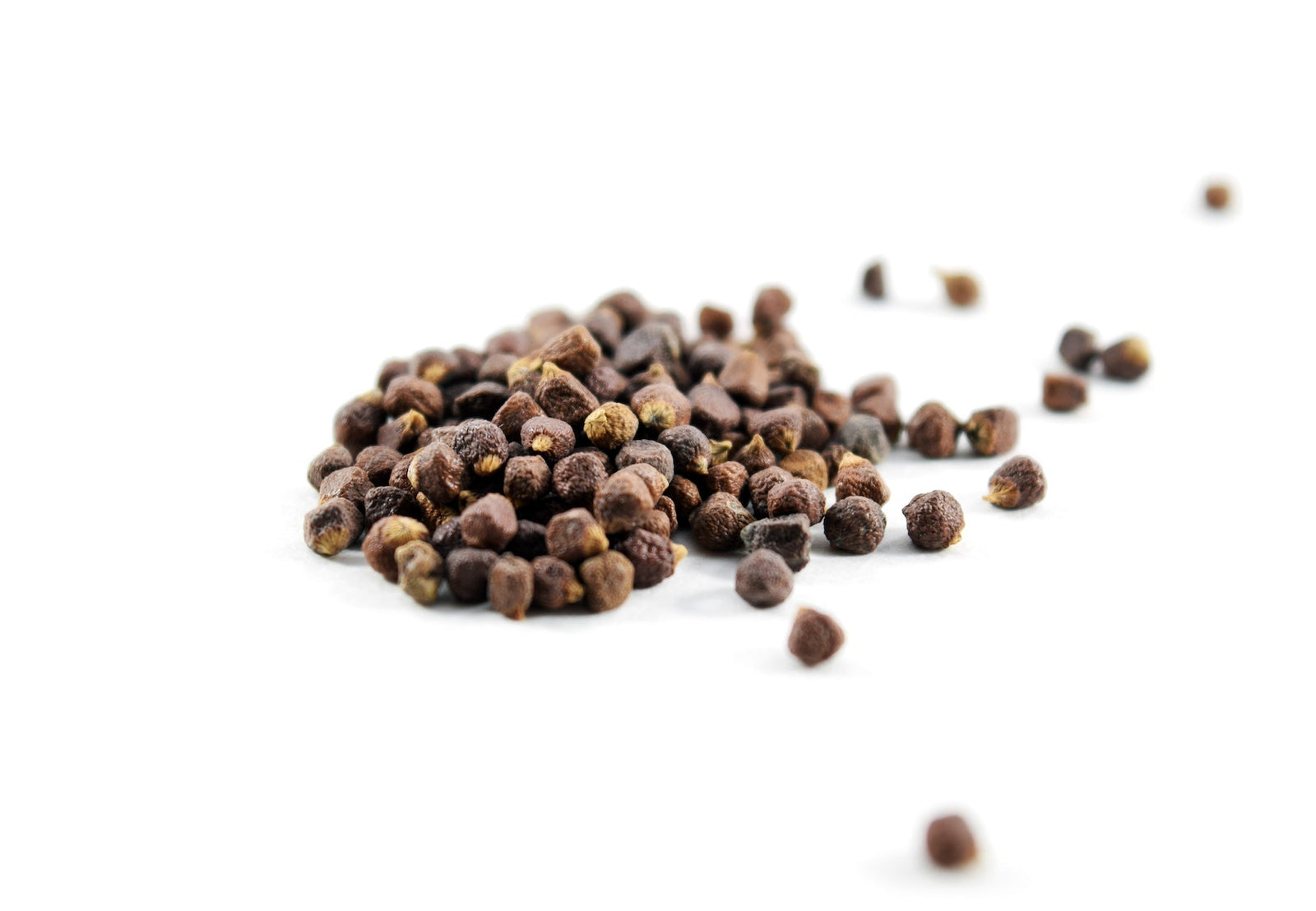When you Google “Grains of Paradise,” you’ll find everything from Martha Stewart recipes to Wikipedia pages about exotic spices. But oddly enough, what you won’t find easily is information about grains of paradise as a dietary supplement.
Like its better-known cousin turmeric, grains of paradise is both a culinary spice and a promising compound in the world of nutritional supplementation. Found in many fat burners under the patented name Paradoxine®, this spice shows scientific promise for supporting fat loss, increasing thermogenesis, and improving body composition.
In this guide, we’ll explore what the research says about grains of paradise, how it works, what the clinical trials reveal, and whether it could help you reach your weight loss goals.
What Is Grains of Paradise (Paradoxine)?
Grains of paradise comes from the Aframomum melegueta plant, a species native to West Africa’s swampy regions. Also known as “melegueta pepper”, its seeds resemble peppercorns and deliver a spicy, citrusy flavor. It belongs to the ginger family and is closely related to cardamom.
As a supplement, it’s often listed as Paradoxine®—a standardized ethanol extract of grains of paradise. The extract contains a group of bioactive compounds known as aframols, which include:
-
6-paradol
-
6-gingerol
-
6-shogaol
-
6-gingerdione
“Paradoxine is a proprietary extract standardized for aframols, a collection of thermogenic ketones derived from Aframomum melegueta.” — Gencor Pacific
How Does Grains of Paradise (Paradoxine) Work?
To understand how Paradoxine may support fat loss, you need to understand the difference between white adipose tissue (WAT) and brown adipose tissue (BAT).
-
WAT stores energy as triglycerides (body fat)
-
BAT dissipates energy as heat (thermogenesis)
Grains of paradise influences BAT activation, triggering a thermogenic effect and increasing overall caloric expenditure.
TRPV1 Activation and Sympathetic Response
Grains of paradise shares structural similarities with capsaicin, the active compound in chili peppers. Both activate the transient receptor potential vanilloid 1 (TRPV1) receptor—a critical player in energy balance, thermogenesis, and fat oxidation.
“Grains of paradise activates TRPV1 receptors, increasing thermogenesis and reducing visceral fat, in a mechanism similar to capsaicin.” — Snitker et al., American Journal of Clinical Nutrition
Pancreatic Lipase Inhibition
In vitro studies show that grains of paradise inhibits pancreatic lipase, an enzyme involved in breaking down dietary fats. This may reduce fat absorption and contribute to weight control.
“Aframomum melegueta extracts inhibit pancreatic lipase in a dose-dependent manner, reducing fat digestion.” — Lee et al., Journal of Ethnopharmacology
Grains of Paradise (Paradoxine) Benefits
1. Increased Thermogenesis and Fat Oxidation
Grains of paradise elevates resting energy expenditure (REE) and supports fat loss by activating BAT. The body burns more calories even at rest, leading to an increase in daily energy expenditure.
“Grains of paradise extract increased energy expenditure by 18.5% and significantly reduced visceral fat in obese subjects.” — Yoneshiro et al., British Journal of Nutrition
2. Improved Body Composition
In a 12-week double-blind placebo-controlled trial, 250 mg of grains of paradise was administered twice daily to 70 obese individuals. The results showed significant improvements in:
-
Thermogenesis
-
BMI
-
Body composition
-
Visceral fat reduction
“Supplementation with 500 mg/day of grains of paradise significantly improved DEXA-measured body composition and fat loss in overweight subjects.” — Maeda et al., Obesity Research & Clinical Practice
3. Synergistic Ingredients for Fat Burners
Because it shares mechanisms with capsaicin, green tea extract, and caffeine, grains of paradise is often stacked with other thermogenics in pre-workouts and fat-burning supplements for an amplified effect.
Grains of Paradise Dosage
Most human trials use doses between 250–500 mg/day of standardized extract, typically divided into two servings (morning and afternoon).
“The effective clinical dose for metabolic and thermogenic benefits appears to be 500 mg of grains of paradise extract daily.” — Yoneshiro et al., British Journal of Nutrition
Grains of Paradise Side Effects
There is limited data on the long-term safety profile of grains of paradise. However, short-term clinical studies have shown it to be well tolerated with minimal side effects.
“Paradoxine is considered safe and shows no significant adverse effects at dosages up to 500 mg per day.” — Gencor Pacific
Based on its similarity to other ginger family compounds like 6-gingerol and 6-shogaol, it is non-toxic and generally safe when used within recommended guidelines.
Common Myths About Grains of Paradise
Myth 1: Grains of Paradise is just a cooking spice.
Fact: While used in cooking, standardized extracts like Paradoxine® are researched for their thermogenic and anti-obesity effects in controlled clinical trials.
Myth 2: It works like caffeine or stimulants.
Fact: Grains of paradise is non-stimulant and works by activating brown fat and TRPV1 receptors, not through central nervous stimulation.
Myth 3: There’s no research behind it.
Fact: Although early, at least three human clinical trials and several in vitro studies support its metabolic effects.
Grains of Paradise (Paradoxine): Takeaway
While the clinical data on grains of paradise is still emerging, early research shows strong promise for its role in increasing thermogenesis, activating brown fat, and reducing visceral fat. It’s an exciting non-stimulant fat loss ingredient, especially when paired with other synergistic compounds.
That said, current evidence is limited to a few well-designed human studies, and more large-scale trials are needed to confirm long-term effectiveness and safety.
If you're looking for a natural ingredient to support your weight loss and energy goals, Paradoxine® may be worth considering—especially in a formula backed by transparent labeling, clinical doses, and third-party testing, like those at Swolverine.







